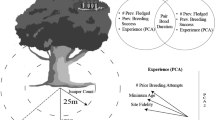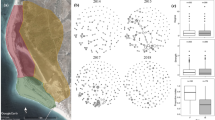Abstract
Consistent, widespread fine-scale preferences for breeding sites may favour the emergence of intrasexual associations and hence sociality. Pairwise association was defined for a terrestrially breeding phocid seal in which intraseasonal colony mixing is limited and mothers spend only 3 weeks ashore breeding. Interannual associations may occur between pairs of breeding female grey seals at North Rona, Scotland because of pupping site fidelity, 90% return rates and limited variability in parturition dates that individual mothers show. Associations can occur when mothers are found together irrespective of location, or because of joint preferences for locations. Mothers were sedentary and were unlikely to interact if they are separated by >20 m. Using spatial and temporal association criteria, 160 of 176 of known mothers had intraseasonal associations with at least one other mother, with 14 of 126 (11.1%) of associations repeated in 2 years. The likelihood of female association in 2 years as a result of site fidelity, parturition date variation and pupping site quality was modelled. Interannual association between mothers that changed their pupping sites by up to the median observed pupping site fidelity (<40 m) was indistinguishable from our model’s predictions. However, the number of mothers that showed interannual association after displacements of >40 m from their previous year’s pupping sites was almost five times greater than the model predicted. We conclude that active association between adult female grey seals is not determined solely by habitat preference, and argue that examination of simple sociality in temporarily aggregating species can contribute significantly to socioecological models of social evolution.



Similar content being viewed by others
References
Alcock J (1993) Animal behavior: an evolutionary approach, 5th edn. Sinauer, Sunderland, Mass.
Amos WA, Twiss SD Pomeroy PP, Anderson SS (1995) Evidence for mate fidelity in the gray seal. Science 268:1897–1899
Andelt WF (1985) Behavioural ecology of coyotes in south Texas. Wildl Monogr 94:45
Anderson SS, Burton RW, Summers CF (1975) Behaviour of grey seals (Halichoerus grypus) during a breeding a season at North Rona. J Zool 177:179–195
Arnold GW, Wallace SR, Rea WA (1981) Associations between individuals and home-range behaviour in natural flocks of three breeds of domestic sheep. Appl Anim Ethol 7:239–257
Axelrod R, Hamilton WD (1981) The evolution of cooperation. Science 211:1390–1396
Black JM (1996) Partnership in birds: the study of monogamy. Oxford University Press, New York
Boness DJ, James H (1979) Reproductive behaviour of the Grey seal (Halichoerus grypus) on Sable Island, Nova Scotia. J Zool 188:477–500
Boyd JM, Laws RM (1962) Observations on the grey seal (Halichoerus grypus) at North Rona in 1960. Proc Zool Soc Lond 164:469–512
Boyd JM, Lockie JD, Hewer HR (1962) The breeding colony of grey seals on North Rona 1959. Proc Zool Soc Lond 138:257–277
Cantoni D, Vogel P (1989) Social organization and mating system of free-ranging greater white-toothed shrews, Crocidura russula. Anim Behav 38:205–214
Connor RC, Heithaus MR, Barre LM (1999) Superalliance of bottlenose dolphins. Nature 397:571–572
Corradino C (1990) Proximity structure in a captive colony of Japanese monkeys (Macaca fuscata fuscata): an application of multidimensional scaling. Primates 31:351–362
Danchin E, Wagner RH (1997) The evolution of coloniality: the emergence of new perspectives. TREE 12:342–347
Devillard S, Allaine D, Gaillard JM, Pontier D (2004) Does social complexity lead to sex-biased dispersal in polygynous mammals? A test on ground dwelling sciurids. Behav Ecol 15:1, 83–87
Dobson FS, Chesser RK, Hoogland JL, Sugg DW, Foltz DW (1998) Breeding groups and gene dynamics in a socially structured population of prairie dogs. J Mamm 79:671–680
Duck CD (2003) Pup production in the British grey seal population. SCOS briefing document, SMRU
Emlen ST (1997) Predicting family dynamics in social vertebrates. In: Krebs JR, NB Davies (eds) Behavioural ecology, an evolutionary approach, 4th edn. Blackwell, Oxford, pp 228–253
Fedak MA, Anderson SS (1982) The energetics of lactation: accurate measurements from a large wild mammal, the Grey seal (Halichoerus grypus). J Zool 198:473–479
Fedak MA, McConnell BJ, Slip DJ, Hindell MA, Reijnders PJ, Burton HR (1998) Close encounters of four kinds: movements of recently weaned elephant seal pups from Macquarie Island. Abstract from World Marine Mammal Science Conference, Monaco
Ferriere R, Michod RE (1996) The evolution of cooperation in spatially heterogeneous populations. Am Nat 147:692–717
Gaggiotti OE, Jones F, Lee WM, Amos W, Harwood J, Nichols RA (2002) Patterns of colonization in a metapopulation of grey seals Nature 416:424–427
Hanggi EB, Schusterman RJ (1990) Kin recognition in captive Californian sea lions (Zalophus californianus) J Comp Psychol 104:368–372
Hiby AR, Duck CD, Thompson D, Hall AJ, Harwood J. (1996) Seal stocks in Great Britain. NERC News, January, pp 20–22
Hinde RA (1976) Interactions, relationships and social structure. Man 11:1–17
Insley SJ (2000) Long term vocal recognition in the northern fur seal. Nature 406:404–405
Kovacs KM (1987) Maternal behaviour and early behavioural ontogeny of grey seals (Halichoerus grypus) on the Isle of May, U.K. J Zool 213:697–715
Krebs JR, Davies NB (1995) An introduction to behavioural ecology, 3rd edn. Blackwell, Oxford
Leuthold BM (1979) Social organization and behaviour of giraffe in Tsavo East National Park. Afr J Ecol 17:19–34
Lima SL, Zollner PA (1996) Towards a behavioral ecology of ecological landscapes. Trends Evol Ecol 11:131–135
McConnell BJ (1986) Tracking grey seals, Halichoerus grypus, using service Argos. MESOGEE 46:93–94
McConnell BJ, Fedak MA (1996) Movements of southern elephant seals. Can J Zool 74:1485–1496
Michod RE (1999) Darwinian dynamics: evolutionary transitions in fitness and individuality. Princeton University Press, N.J.
Michod RE, Sanderson MJ (1985) Behavioural structure and the evolution of social behaviour. In: Greenwood JJ, Slatkin M (eds) Evolution—essays in honour of John Maynard Smith. Cambridge University Press, Cambridge, pp 95–106
Newton I (1989) Lifetime reproduction in birds. Academic, London
Pepper JW, Smuts BB (2002) A mechanism for the evolution of altruism among non-kin: positive assortment through environmental feedback. Am Nat 160:205–213
Pomeroy PP, Anderson SS, Twiss SD, McConnell BJ (1994) Dispersion and site fidelity of breeding female grey seals (Halichoerus grypus) on North Rona, Scotland. J Zool 233:429–447
Pomeroy PP, Twiss SD, Duck CD (2000a) Expansion of a grey seal breeding colony: changes in pupping site use at the Isle of May, Scotland. J Zool 250:1–12
Pomeroy PP, Twiss SD, Redman P (2000b) Philopatry, site fidelity and local kin associations within grey seal breeding colonies. Ethology 106:899–919
Pomeroy PP, Wilmer JW, Amos W, Twiss SD (2001). Reproductive performance links to fine-scale spatial patterns of female grey seal relatedness. Proc R Soc B 268:711–717
Raum-Suryan KL, Pitcher KW, Calkins DG, Sease JL, Loughlin TR (2002). Dispersal, rookery fidelity, and metapopulation structure of Steller sea lions (Eumatopias jubatus) in an increasing and in a decreasing population in Alaska. Mar Mamm Sci 18:746–764
Redman P, Pomeroy PP, Twiss SD (2001) Grey seal maternal attendance patterns are affected by water availability on North Rona, Scotland. Can J Zool 79:1073–1079
Redman P (2002) The role of temporal, spatial and kin associations in grey seal breeding colonies. PhD thesis, University of St. Andrews, Scotland
Robson BW, Baker JD, Goebel ME, Ream RR, Antonelis GA, Loughlin TR, Costa DP, Towell RG (1998) Relationship between foraging location and breeding sites of post-parturient Northern fur seals, Callorhinus ursinus. Abstract from World Marine Mammal Science Conference, Monaco
Shrader AM, Owen-Smith N (2002) The role of companionship in the dispersal of white rhinoceroses (Ceratotherium simum). Behav Ecol Sociobiol 52:255–261
Smuts B, Cheney D, Seyfarth R, Wrangham R, Struhsaker T (1987) (eds) Primate societies. University of Chicago Press, Chicago
Sterck EHM, Watts DP, van Schaik CP (1997) The evolution of female social relationships in nonhuman primates. Behav Ecol Sociobiol 41:291–309
Sugiyama Y (1988) Grooming interactions among adult chimpanzees at Bossou, Guinea, with special reference to social structure. Int J Primat 9:393–407
Thompson D, Hammond PS, Nicholas KS, Fedak MA (1991) Movements, diving and foraging behaviour of grey seals (Halichoerus grypus). J Zool 224:223–232
Thompson PM, McConnell BJ, Tollit DJ, Mackay A, Hunter C, Racey PA (1996) Comparative distribution, movements and diet of harbour and grey seals from the Moray Firth, N.E. Scotland. J Appl Ecol 33:1572–1584
Trillmich F (2002) Sociobiology In: Perrin WF, Würsig B, Thewissen JGM (eds) Encyclopedia of marine mammals. Academic, New York, pp 1117–1124
Twiss SD, Caudron A, Pomeroy PP Thomas CJ, Mills JP (2000a) Fine scale topographical correlates of behavioural investment in offspring by female grey seals, Halichoerus grypus. Anim Behav 59:327–338
Twiss SD, Pomeroy PP, Thomas CJ, Mills JP (2000b) Remote estimation of grey seal length, width and body mass from aerial photography. Photogr Eng Remote Sensing 66:859–866
Twiss SD, Thomas C J, Pomeroy PP (2001) Topographic spatial charactisation of grey seal Halichoerus grypus breeding habitat at a sub-seal size spatial grain. Ecography 24:257–266
Twiss SD, Duck C, Pomeroy PP (2003) Grey seal pup mortality is not explained by local breeding density on the island colony of North Rona, Scotland. J Zool 259:83–91
Waser PM (1996) Patterns and consequences of dispersion in gregarious carnivores. In: Gittleman JL (ed) Carnivore behaviour, ecology and evolution, vol 2. Cornell University Press, Ithaca, N.Y., pp 267–295
Waser PM, Waser MS (1985) Ichneumia alhicauda and the evolution of viverid gregariousness. Z Tierpsychol 68:137–151
Whitehead H, Dufault S (1999) Techniques for analyzing vertebrate social structure using identified individuals: review and recommendations. Adv Stud Behav 28:33–75
Acknowledgements
The authors thank S.N.H., P.D.G. and the Coastguard Agency for help and support in the field. We thank all those who assisted in fieldwork, particularly Simon Moss for unstinting efforts above and beyond the call of duty. Mike Lonergan kindly assisted analyses. Rob Harcourt assisted data collection enthusiastically in 2000 but snored very loudly. NERC supported research through core funding to SMRU, to S.D.T. through a Postdoctoral Research Fellowship (1998–2000) and P.R. was supported by a NERC studentship during the work. All work was carried out under Home Office licence.
Author information
Authors and Affiliations
Corresponding author
Additional information
Communicated by F. Trillmich
Rights and permissions
About this article
Cite this article
Pomeroy, P.P., Redman, P.R., Ruddell, S.J.S. et al. Breeding site choice fails to explain interannual associations of female grey seals. Behav Ecol Sociobiol 57, 546–556 (2005). https://doi.org/10.1007/s00265-004-0882-6
Received:
Revised:
Accepted:
Published:
Issue Date:
DOI: https://doi.org/10.1007/s00265-004-0882-6




